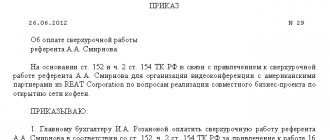What is forced absenteeism?
At the moment, there is no single norm that would fully define the concept of forced absenteeism, as well as ways to resolve such emerging conflicts.
In judicial practice, it is generally accepted that forced absenteeism will be considered all periods of time when an employed citizen could not perform his work duties due to the unilateral fault of the company administration. And this is impossible without violation of labor laws by the employer. The most common forms of committing illegal actions in this category:
- illegal dismissal (the period for resolving the dispute and the time until the employee is reinstated in his previous place implies compensation for forced absence, since the situation is classified this way);
- unauthorized transfer of a worker to a position with a lower salary (such a decision affects wages, and absenteeism is paid by calculating the difference in salaries for different positions);
- violation of the rules for filling out a work book or issuing it late, which prevents urgent employment at a new place of work.
If the employee was illegally dismissed, the court decided to return the employee to work within a specific time frame, and the director delays reinstatement at his previous job, then the downtime will also be considered forced absenteeism and must be included in the citizen’s length of service.
Taxation when paying for forced absence
The Tax Code of the Russian Federation (Article 210) establishes the obligation to deduct income tax from any type of income of individuals (NDFL).
The same legislative act lists a list of payments from which the said tax is not withheld - these are social benefits, pensions, compensation payments related to dismissal and a number of others.
Important
There is no specific payment for forced absence among them.
At the same time, legal practice on the issue of taxation of compensation for forced downtime in work has developed differently. This is due to the fact that lawyers regarded the payment not as income, but as compensation. This point of view was supported by the Department of Tax Administration for Moscow (letter dated February 27, 2004 No. 28-11/12809), the Federal Antimonopoly Service for the Moscow Region (resolution dated December 8, 2008).
The dispute was brought to an end by letters from the Ministry of Finance of the Russian Federation dated July 24, 2014 No. 03 04 05/36473, dated April 13, 2012 No. 03 04 05/3 502, the Federal Tax Service of the Russian Federation dated April 4, 2006 No. 04 1 04/190, which indicate that the legal grounds There is no exemption from personal income tax on the amount of compensation for forced absence by court decision.
Despite the fact that in the courts the issue of applying tax to the amount of compensation is decided in favor of the employee, in practice it is recommended to use the official position of the Russian Ministry of Finance.
Important
Compensation for moral damage to an employee in case of illegal dismissal, made by court decision, is strictly compensatory in nature and is not subject to taxation.
Legal aspects
When considering disputes related to the removal of a citizen from work duties, the following legal documents are taken into account:
- Labor Code of the Russian Federation (fixes the procedure for attracting individuals to work, the conditions for transfer between positions, as well as legal grounds for termination of a contract);
- Resolution of the Plenum of the Supreme Court dated March 17, 2004 No. 2 (provides detailed explanations regarding the application of labor legislation in practice);
- On December 24, 2007, Government Resolution No. 922 “On the rules for calculating wages” was adopted.
It is also necessary to take into account the company’s internal regulations, which record the individual characteristics of the work activity.
The procedure for recognizing absenteeism as forced
In general, an employee’s absence from work is recognized as forced absence on the basis of a corresponding decision of the State Labor Inspectorate or in accordance with a court decision.
In case of illegal dismissal or in connection with denial of access to the workplace without explanation, a citizen has the right to appeal to the labor commission. The filing period should not exceed 3 months from the moment the employee learned of a violation of his or her labor rights. In case of illegal dismissal, the application period is reduced to 1 month.
The State Tax Inspectorate considers the applicant’s appeal in the prescribed manner. If a citizen has provided compelling arguments (including documentary ones) for his own claim, the State Tax Inspectorate satisfies the applicant’s demands and makes a decision recognizing the absence as forced, and the period of absence as payable.
If claims for illegal dismissal are satisfied, the State Tax Inspectorate makes a decision to reinstate the employee in the workplace. In this case, forced absenteeism subject to payment is recognized as the period from the moment of illegal dismissal to the day of reinstatement at work.
A citizen has the right to defend his labor rights in court if:
- The State Tax Inspectorate did not satisfy the employee’s claims and did not recognize the absence as forced;
- The deadline for filing a claim with the State Tax Inspectorate has expired.
In each of the listed cases, a citizen can draw up a statement of claim and submit it to a district court of general jurisdiction. Consideration of cases of illegal dismissal (suspension from work) is carried out within the framework of standard judicial proceedings. If a decision is made in favor of the plaintiff, the period of absence of the employee from work is recognized as forced absence.
Causes
In practice, it is necessary to distinguish the concept of absenteeism from forced absenteeism. In the first case, we mean all facts of the absence of an employed citizen from the workplace for more than four hours without good reason. If an employee cannot perform his duties due to circumstances beyond his control (except for sick leave), then these are forced measures.
Due to the employer's fault
Most often, such violations occur through the fault of the director due to failure to comply with the legal requirements of the Labor Code. These include:
- illegal dismissal of an employee;
- unjustified reluctance to accept an applicant for work;
- signing a work contract late, that is, when the citizen is already unofficially employed.
If a violation is confirmed, the average earnings for the period of absenteeism are calculated. Based on the amounts received, the injured citizen is provided with monetary compensation.
Due to the employee's fault
Forced absenteeism due to the fault of an employee usually means all facts of legal absence from the workplace. Such circumstances include:
- opening of sick leave;
- summons to the police or court (be sure to attach a summons);
- disaster.
Only those absences will be counted when the employee, contrary to his desire to work, was unable to begin production activities.
We recommend reading: Procedure for dismissing an employee for absenteeism
How to recover compensation for forced absence when reinstated at work?
Labor legislation, as well as other regulatory documents, establish a number of grounds for terminating all relations with an employee. However, enterprises often ignore established regulations and fire people in violation of the law. Is it possible to restore your violated labor rights and hold your employer accountable? Here is a description of the situation one of our clients found themselves in.
I worked at one of the enterprises. After returning from vacation, they announced to me that I was fired without giving any reasons. Can I somehow influence the employer and be reinstated in my previous position? If yes, what is the best way to do this? Sergey, Izhevsk.
You can challenge your dismissal in several ways. For example, you can file a complaint with the labor inspectorate, as well as an application with the labor dispute commission. However, as practice shows, the most effective way to get reinstated at work is to file a lawsuit. To do everything correctly, we advise you to follow our instructions.
Consult a lawyer
Many people do not know all of their labor rights. Therefore, in case of illegal dismissal, you should not delay in contacting our lawyers. We will not only analyze the situation comprehensively, but also suggest what is the best thing to do to get reinstated at work. Remember that dismissal may be illegal even when the administration applied the wrong article of the Labor Code when terminating the relationship. In this case, the person’s reputation in the eyes of future employers may suffer. Therefore, the help of a lawyer may consist of changing the wording of the reasons for dismissal.
Gather the documents necessary to go to court
It is impossible to win a dispute with an employer without having strong evidence to prove that you are right. Our specialist will help you navigate through their list. In particular, copies of the employment contract and work record book must be attached to the claim. In addition, you may need a certificate of income, as well as other documents. In some cases, when reinstated at work, the court may hear witnesses. Therefore, it is advisable to decide in advance on the circle of people who can take your side in the conflict.
Determine the grounds for challenging dismissal
You can cancel your dismissal for many reasons. This includes incorrect application of labor legislation and violations of the dismissal procedure. Even failure to comply with the most insignificant formality on the part of the employer can play into your hands.
Calculate all amounts due to you
Along with your reinstatement at work, the claim should raise the issue of recovery of average earnings for the entire period of absenteeism, as well as recovery of moral damage caused by dismissal, and other sanctions. Our lawyers will help you calculate all compensation taking into account inflation. As for moral damages, you can determine the amount yourself based on the inconvenience caused to you.
Prepare a statement of claim to the court
To be reinstated at work, you must file a claim in the district court at the employer's location. The statement of claim does not require payment of a state fee, since it is closely related to your labor rights. A claim is being prepared with attachments in triplicate: for the court, the defendant and you.
Attend all meetings
It is very difficult to achieve a positive decision for yourself without participating in court hearings. After all, the judge must understand a clear picture of the situation for himself. To do this, he may ask you or your representative questions or request additional evidence. All questions should be answered clearly, without fear of pressure from the opposite side. In addition, during the process, you can provide additional explanations that are not reflected in the claim.
Wait for the decision to come into force and receive a writ of execution
If the decision to reinstate you at work and collect payments for forced absence is made in your favor, then you need to consider the following. In terms of reinstatement at work, the court decision must be executed immediately. The same applies to salary debts for no more than 3 months. For other payments, you must wait until the court decision comes into force. This will happen either after the deadline for the employer to file an appeal has expired (a month after the court makes a final decision), or immediately after its consideration. Therefore, you may have two writs of execution in your hands: one for reinstatement at work, and the other for the collection of awarded amounts.
Resume your previous job responsibilities
Having received a writ of execution for reinstatement at work, hand it over to your employer and return to your work. Make sure that the employer cancels the order to dismiss you and makes a corresponding entry in the work book. If the administration avoids taking such actions, contact the bailiffs at the location of the enterprise in order to initiate enforcement proceedings. If the original writ of execution is with the employer, contact the court to obtain a copy of it.
Initiate enforcement proceedings regarding compensation
Enforcement proceedings are also opened regarding the awarded compensation and moral damage resulting from illegal dismissal and forced absenteeism. To do this, bailiffs need to write an application to initiate enforcement proceedings, attaching the original writ of execution. The bailiffs will then be in charge of collecting the amounts due to you.
Unlawful dismissal is a painful process for many. Lawyers from Legal will help you restore your rights and recover all payments due to you. We will not only provide a free online consultation. In our online store of legal services, you can order a statement of claim drawn up specifically for your specific situation.
employee rights instructions
Payment procedure for forced downtime
The amount of payment for idle time allowed by the employer is affected by the duration of the period when the citizen did not begin to perform his official duties. To do this, simply sum up all the days during which the specialist was suspended from work.
How is it calculated
The employee’s right is to receive monetary compensation for forced absenteeism, since the citizen, through someone else’s fault, lost his official income. The amount of compensation accruals is determined according to the following algorithm:
- Counting the days during which the forced downtime order was in effect. Only working days are taken into account, and weekends and public holidays are excluded from the list.
- Establishing average daily income. The general salary indicators for the previous two calendar years are taken as a basis.
ATTENTION! There is a legal basis to reduce the amount of compensation, but only if the director of the enterprise provided the citizen with severance pay during the illegal dismissal. This amount is withheld from potential compensation.
The second point to pay attention to is cases of transfer of a citizen to another position with a lower salary. In this case, the difference in salaries is calculated - a coefficient on which the maximum amount of deductions will depend.
What is not included in the calculation
Collection of wages during forced absences takes into account the salary, regular allowances and bonuses, as well as insurance payments. The following categories of income will not be considered:
- travel money;
- compensation for the cost of professional training;
- financial support from trade union organizations.
IMPORTANT! Income tax is required to be withheld from the compensation received. For Russian residents, personal income tax is 13%.
Calculation formula
The formula for calculating compensation includes the following indicators:
- ADD – average daily income of an employed citizen;
- KDP – number of days of absenteeism;
- SK – compensation amount.
Compensation is calculated as follows:
SK = SDD * KDP
Payment amount calculation
The amount of payment for forced absence is determined for its entire period.
Attention
The basis for calculation is the citizen’s earnings for the 12 months before the wrongful dismissal. In situations where the duration of work is less than 1 year, the calculation is made taking into account the average daily earnings.
According to Decree of the Government of the Russian Federation dated December 24, 2007 No. 922, the average salary includes all charges established by the wage system, and additional material guarantees are not included. The procedure for calculating average earnings is outlined in Article 139 of the Labor Code of the Russian Federation.
| Taken into account when calculating payments in case of illegal dismissal | Payments are not taken into account |
| Salary | Financial assistance from trade union bodies |
| Allowances (for complexity, intensity, special conditions, etc.) | Funds for advanced training |
| Insurance funds | Compensatory payments for food and travel |
| Awards | Other social payments |
Attention
When indexing the amount of salary in an organization during forced downtime, the payment is calculated with an increasing coefficient, proportional to the duration of the increased salary in the billing period.
The number of days of unlawful downtime is calculated from the date following the day of dismissal until the day of reinstatement.
In case of dismissal, the employee is compensated for unused vacation for the time actually worked, which is not included when calculating payments for illegal downtime.
Attention
The fact of providing unemployment benefits, disability benefits, or payment under civil contracts to a wrongfully dismissed specialist during forced absence does not constitute grounds for refusal of compensation by a court decision.
Formula for calculating the accrual for forced absence:
Amount = SWP (average wage) × number of downtime days.
The average salary is determined by dividing the amount of accrued payments for 12 months by the period the employee performed his duties (i.e., the time actually worked).
Important
Only working days are taken into account!








